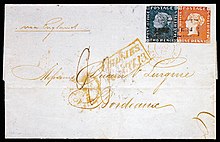| This article's lead section may be too short to adequately summarize the key points. Please consider expanding the lead to provide an accessible overview of all important aspects of the article. (January 2023) |

Arthur Hind (1856–1933), of Utica, New York, was a British-born American textile industrialist and philatelist.
Business interests
He was born in Bradford, United Kingdom, and later lived on Maple Street in Utica, New York, in the Mohawk Valley. He was owner of Hind-Harrison Plush Co. in Clark Mills, New York, which made upholstery fabrics for automobile manufacturers. He immigrated to the United States from Bradford in 1890. He became an American citizen in July 1896.
Philatelic activity
Hind formed an outstanding collection of stamps of the United States. Like Thomas Tapling, Hind poured the profits from his business into rare stamps, and soon acquired many of the world's greatest rarities. Among these were the Bordeaux Letter, which Roger Calves considered "le plat de résistance (main course) de toute la philatélie" or "the greatest item in all philately", purchased in 1922 from Alfred F. Lichtenstein. He also owned the two "Post Office" Mauritius stamps, both unused, purchased from Henry Duveen. At the Ferrary sale, Hind purchased the One Cent Magenta British Guiana for a world-record price, as well as all of the best U.S. Postmasters' Provisionals.
According to Alexander Séfi, because of his obsession with the "black on magenta," Hind (according to rumor) bought not only one of the stamps, but the other remaining one, and then destroyed one so that he would own the only one in the world.
After Hind died, his American stamps were sold at auction for $247,000, in November 1933. The following February his nephew, F.J.M. Hinds, bought all the remaining stamps from the collection, preventing them from going to auction. He immediately transported them to England.
References
- Brown, Mark (28 Apr 2021). "World's most valuable stamp expected to sell for up $15m in New York". The Guardian. ISSN 0261-3077. Retrieved 2023-02-13.
- "Hind, Arthur (1856–1933)", helenmorgan.net. Accessed January 8, 2023.
- Stamps: A Weekly Magazine of Philately. H.L. Lindquist. September 1932. p. 261.
Arthur Hind...became an American citizen in July, 1896
- Roger Calves, quoted in David Feldman SA, Mauritius: Classic Postage Stamps and Postal History Switzerland (1993) p. 92.
- "Outbid King George for $32,000 stamp", New York Times (May 14, 1922)
- Séfi, A. J., "Obituary. A Short Memoir of Mr Arthur Hind", Philatelic Journal of Great Britain, vol. 43, no. 507 (March 1933), pp. 46–47.
- "Hind's Nephew Buys Stamp Collection". The New York Times. February 24, 1934. Retrieved April 10, 2022.
External links
 Media related to Arthur Hind at Wikimedia Commons
Media related to Arthur Hind at Wikimedia Commons
